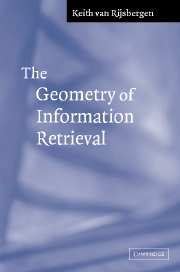Book contents
- Frontmatter
- Contents
- Preface
- Prologue
- 1 Introduction
- 2 On sets and kinds for IR
- 3 Vector and Hilbert spaces
- 4 Linear transformations, operators and matrices
- 5 Conditional logic in IR
- 6 The geometry of IR
- Appendix I Linear algebra
- Appendix II Quantum mechanics
- Appendix III Probability
- Bibliography
- Author index
- Index
Appendix II - Quantum mechanics
Published online by Cambridge University Press: 14 January 2010
- Frontmatter
- Contents
- Preface
- Prologue
- 1 Introduction
- 2 On sets and kinds for IR
- 3 Vector and Hilbert spaces
- 4 Linear transformations, operators and matrices
- 5 Conditional logic in IR
- 6 The geometry of IR
- Appendix I Linear algebra
- Appendix II Quantum mechanics
- Appendix III Probability
- Bibliography
- Author index
- Index
Summary
One should keep the need for a sound mathematical basis dominating one's search for a new theory. Any physical or philosophical ideas that one has must be adjusted to fit the mathematics. Not the other way around.
Dirac, 1978.This appendix will give a brief, highly simplified introduction to a number of the principles underlying quantum theory. It is convenient to collect them here independent of information retrieval. We will use the Dirac notation introduced in the previous appendix to express the necessary mathematics. Before examining the few principles underlying quantum mechanics let us make two comments. The first is that there is no general agreement about whether probabilistic quantum statements apply to individual isolated systems or only to ensembles of such systems identically prepared. The second comment is that there is no distinct preference whether to develop quantum theory fully in terms of vectors in a Hilbert space, or in terms of the density operators applied to that space. We will not take a strong position on either division. For convenience we will assume that statements are applicable to single systems, and that when it suits, either vectors or density operators can be used.
To begin with we will consider only pure states of single systems and observables with discrete non-degenerate spectra. This will keep the mathematics simple.
There are four significant fundamental concepts to consider: physical states, observables, measurements and dynamics; and of course the interplay between these.
- Type
- Chapter
- Information
- The Geometry of Information Retrieval , pp. 109 - 115Publisher: Cambridge University PressPrint publication year: 2004

